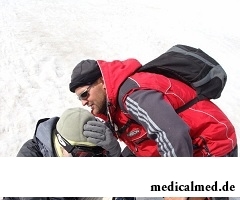





Mountain disease
Mountain disease – disease state which arises at ascension to mountain areas. A mountain disease – the kind of a hypobaropathy arising because of air hunger (hypoxia) at rise on considerable heights. The similar state is familiar to climbers, geologists at ascension on height or rise on motor transport. Deterioration in health at rise for the first time was described by Akoste. In more detail influence of height on a human body began to be studied only in the nineteenth century.
Reasons of a mountain disease
The mountain disease usually begins to be shown at the height about two and a half thousand meters above sea level. It is considered that the main reason of a mountain disease – low concentration of oxygen in the inhaled air. However, concentration of oxygen remains invariable at different heights. With increase in height atmospheric pressure changes, and because of it the ratio of hydrogen and oxygen in air begins to vary. The organism at height receives less oxygen, than it is required for normal functioning of a brain and a body of the person.
Symptoms and pathogeny of a mountain disease
The mountain disease is seldom shown suddenly, most often it develops gradually. Its first symptoms are muscular weakness, apathy, dizziness, drowsiness, an indisposition. Symptoms of a disease accrue if the person remains at height. There is vomiting, nausea, fever, a fever and frustration of a respiratory rhythm.
The mountain disease quite often arises at people with cardiovascular diseases, chronic pulmonary diseases.
In a pathogeny of a mountain disease allocate a stage of adaptation and a stage of compensation, and also a stage of a decompensation and, actually, a disease.
The stage of compensation is shown at the height from one thousand to four thousand meters above sea level. At this stage of a mountain disease there is tachycardia, short wind, arterial pressure as a result of reflex stimulation of the cardiovascular and respiratory centers (increases at irritation of chemoceptors hypoxemic blood).
At the height from four to five thousand meters excitement of cells of bark of big hemispheres amplifies and internal inhibition is weakened. Against the background of a lack of oxygen there is a considerable emission of blood from depot, in marrow the erythrogenesis becomes more active, and in peripheral blood the quantity of erythrocytes increases. Very often at this stage of development of a mountain disease there is a loss of writing skills, there is an irritability, handwriting changes.
The stage of a decompensation develops at the height from five thousand meters and more. The hyperventilation of lungs leads to decrease in fabrics of concentration of carbonic acid. As a result of development of acidosis and a gas alkalosis excitability, especially cardiovascular and respiratory centers decreases. Excitement and euphoria of an organism are replaced by a depression of the central nervous system and oppression. At this stage of a disease develop drowsiness, fatigue, the majority of reflexes many functions of a digestive tract are braked, oppressed, because of the expressed myocardium hypoxia arterial pressure considerably goes down. Microcirculation is broken, breath becomes uneven. At the height from six to eight thousand meters paralysis of a respiratory center can lead to an apnoea.
On changes from external respiration and blood allocate two main forms of a mountain disease – emphysematous and eritremichesky. In separate a case serious complications (wet brain and/or lungs) can develop also at smaller height.
Prevention of a mountain disease
Before departure on heights from five to eight kilometers it is previously necessary to adapt respiratory, muscular, cardiovascular and hemopoietic systems. For prevention of a mountain disease it is the best of all to rise by rather small heights at first. At long stay at small height in an organism there occur the changes allowing to keep normal life activity.
Observations showed that climbers who very often rise to mountains almost do not suffer from a mountain disease.
For each person adaptation to shortage of oxygen demands various time. At young age (from 24 to 35 years) acclimatization happens rather quickly. Already approximately in a week of stay at the height from two to three thousand meters compensatory mechanisms of an organism therefore the volume of lung ventilation increases become more active, the quantity of erythrocytes and concentration of hemoglobin in blood increases, forms of dissociation and the oxygen capacity of blood change, alkalinity of blood increases, the heart muscle hypertrophy develops. As a result of activation of compensatory mechanisms of an organism resistance of fabrics to air hunger increases.
The complex of actions for acclimatization increases endurance of an organism. For prevention of a mountain disease it is very important to organize correctly food and the water-salt mode at stay at considerable height. During adaptation of an organism it is very important to drink a large amount of liquid (about three liters a day). Liquid accelerates removal of nedookislenny products of metabolism by kidneys. For acclimatization acceleration reception of citrate sodium, chloride ammonium, hypochloric potassium, and also introduction of intravenously methylene blue and inhalation of carbonic acid is also recommended.
Before ascension for acceleration of adaptation it is also very useful to train systematically in a pressure chamber by a special technique.
Very important method of prevention of a mountain disease is ultra-violet radiation and inhalation of the gas mixes which are grown poor by oxygen.
People who got used to have breakfast regularly have obesity much less often.

Each person has easy indispositions which he transfers "standing", trying not to ask for medical care. Argu...
Section: Articles about health
Condition of lips (their morbidity, outward) – one of indicators of health of the person. The peeling, dryness, pallor, and also cracks in corners of a mouth can be not only the cosmetic shortcoming which arose owing to physical damages and weather having sent away...
Section: Articles about health
About 20% of the population of our planet have a hypertension (permanent increase in arterial pressure). This disease has an adverse effect on the standard of living, reduces working capacity, and in the absence of systematic treatment threatens with such complications as a myocardial infarction, a stroke and other heavy illnesses which can result in disability or sudden death. Most of patients for maintenance of pressure at more or less acceptable level accept appointed doctors лекарст...
Section: Articles about health
The cosmetics intended for improvement of a condition of skin, nails and hair are used by each woman. Expenses on регуля...
Section: Articles about health
Each failure in work of bodies and systems of a human body is, as a rule, shown by the whole complex of symptoms. In particular, malfunctions with health often cause emergence of cosmetic defects in the form of rashes on a face. Experienced doctors know that локализац...
Section: Articles about health
Let's begin with the fact that a separate illness which is called "adjournment of salts", just does not exist. In practice this household name of disbolism leading to development of a number of diseases. Pathological process consists that in an organism there is an accumulation of salts of uric acid (as a rule, owing to failure of a water salt metabolism or insufficiently effective work of secretory system)....
Section: Articles about health
Many of us, probably, noticed more than once that from intellectual loadings at some point the brain as though "overheats" also "assimilation"...
Section: Articles about health
Health and attractiveness - eternal values, pursuing which people often use the most unusual ingredients and technicians. Let's consider 11 most exotic and sometimes not most pleasant Spa procedures to which the person in a pursuit for beauty agrees...
Section: Articles about health
The varicosity has familiarly many, statistically, this disease more than a half of all adult population. As a rule, the varicosis affects preferential superficial vessels, and is shown by characteristic cosmetic defects. The deep vein thrombosis as this illness at the initial stages can imperceptibly proceed is represented much more dangerous, and in the started cases threatens with serious danger – thrombosis. This state, when the blood clot formed...
Section: Articles about health
Statistically, at the address to doctors seven of each ten patients complain of a headache. Actually people, periodically...
Section: Articles about health
It would seem, about it there can be no disagreements: water is necessary for a human body for normal life activity, and about how and when it should be drunk, all know. It turned out that the situation is not absolutely so: for many years occur ве...
Section: Articles about health
What they, women? Beautiful, gentle, passionate and at the same time windy, gusty, and nervous. And what is stranger: have all these qualities of the woman at the same time. But here only the mood their time sharply changes on completely opposite: in the morning they laugh and joke, and in the evening cry or are irritated....
Section: Articles about health
Traveling all over the world, many try to try the most exotic dishes of national cuisines. Exists even so-called died away...
Section: Articles about health
The technique of acupuncture (acupuncture) is used in the medical purposes more than three and a half millennia. It is eurysynusic and recognized as official medicine in the majority of the developed countries of the world. Influence by fine needles on so-called points...
Section: Articles about health
For anybody not a secret that our country is one of the most "drinking" in the world. At clear understanding that the use of hard alcoholic drinks – occupation extremely harmful, most of Russians belong to alcoholism with unjustified loyalty. Apparently, existence of a set of myths in which tendency to excessive libations looks nearly positively is explained by it. It is worth getting acquainted with the most widespread of similar delusions and to be convinced in them not...
Section: Articles about health
Vitamin complexes belong to the most popular drugs, probably, in our country there is no person who was not hearing about a floor...
Section: Articles about health
The pancreas performs two functions in a human body: release of enzymes without which digestion of carbohydrates, fats and proteins, and a producing hormones is impossible. The most important of them - insulin, is the main participant of carbohydrate metabolism, a normal...
Section: Articles about health
For residents of the countries of Southeast Asia various algas are an obligatory component of a daily diet. Their popularity is connected not only with high tastes, but also with numerous curative properties. Russians are a little familiar with products such that is distressing: algas are so useful that they should be eaten as often as possible. Let's get acquainted closer with useful properties of this seafood....
Section: Articles about health
Any of us is not insured from a heavy illness of the loved one. Happens and so that someone from family members becomes lying бо...
Section: Articles about health
For the help to doctors in the choice of optimal solutions for treatment of various diseases the Cochrane scientific organization (Cochrane) conducts joint researches with representatives of scientific community around the world. The analysis of a series became carried out by one of the last methanolyses...
Section: Articles about health
It is pleasant to state a possibility of improvement of quality of life of people with problems of functioning of secretory system. Efforts of talented inventors created products which will be able to provide normal life activity of clients with moderate degree of a disease, it is essential to facilitate the help to patients with strongly expressed disturbances....
Section: Articles about health
Healthy lifestyle today in fashion, and many parents think of that the child from the early childhood played sports. To a Torah...
Section: Articles about health
A lot of things depend on a condition of a backbone in a human body, a backbone - not only a support for a body, it also a receptacle for a spinal cord, that is why malfunctions with a backbone are so dangerous. To treat rachis diseases very difficult and long...
Section: Articles about health
Memory is an ability of the central nervous system to fix, keep and as necessary to reproduce information on knowledge or skills received by the person or an animal during life. The mechanism of this process is up to the end not studied....
Section: Articles about health
Sugar - the digestible refined product which is not of special value for an organism of the modern person. Use...
Section: Articles about health
Feeding by a breast - the integral part of ideal motherhood allowing to come into contact with the kid and to create to it healthy immunity since early years. Nevertheless, this important process in life of mother and child can be saddened laktostazy − by a delay of milts...
Section: Articles about health
Maternal milk is the best food for the newborn. It is the unique natural product containing an optimum set of nutrients, and which is best adapted in order that the baby normally developed and it was protected from harmful factors of external environment, unusual for it. Unfortunately, breastfeeding process not always does without complications. Sometimes, that the kid begins to bite a breast, giving to mother an essential inconvenience. Some women...
Section: Articles about health
